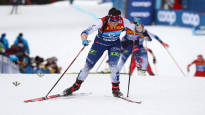In January 2007, in pitch darkness, the Finnish coaches tested whether the final ascent of Alpe Cermis was worth going up with holding ropes. The work was wasted when a text message came from the head coach.
The cross-country skiing world was feverishly waiting for a completely new challenge at the beginning of the 2006-2007 season. The last stage of the Tour de Ski, the newcomer to the tour, i.e. the Alpe Cermis ski slope with more than 400 meters of ascent, was at least awe-inspiring.
– It was even treated with fear. I had been to Val di Fiemme many times, but when I heard the name, I couldn’t even immediately connect which slope it was, recalls the coach of the Finnish national team at the time Eero Hietanenhead coach of Rovaniemi-based Santasport.
FIS cross-country competition director at the time Jürg Capol had come up with the idea of the final stage together with another influencer of the sport, a skiing legend who led a long speech in the FIS cross-country committee Vegard Ulvang with.
– We took a sauna at Vegard’s place in Oslo in August 2004 and planned the final ascent. We drank a couple of bottles of beer at the same time, Capol recalls.
– There was also a lot of opposition. For example, Finland’s head coach at the time Magnar Dale didn’t hide the fact that he didn’t think the idea of an ending was reasonable.
The most watched competition
Although the final ascent in itself has nothing to do with normal competitive skiing, Capol, who has also been marketing director of FIS for a long time, reminds us that since the beginning it has been the most watched TV part of the World Cup in the cross-country skiing season.
– Vegard and I were of course worried about how it would look on TV. Would the speed of the skiers die completely in the hardest parts of the track?
The climb angle in Alpe Cermis is at its worst 28 percent.
Capol says that another option for the final stage was the beautiful route from Cortina-Toblach in Italy.
– However, it would not have been the same spectacle. Alpe Cermis is as much a concept in skiing today as the climbs of Tourmalet or Mont Ventoux are in cycling, and Vegard and I looked specifically for a model from the classics of road cycling.
The rumor started to spread
Hietanen says that there was a lot of uncertainty in the air when the teams arrived at the last competition location, Val di Fiemme. At most, the skiers had gone under the final ascent or had ascended part of it. The track was not even marked with blue paint the first time, as it has been since then.
– A rumor started to spread that some teams might go up the hill with uphill climbs, Hietanen says.
In 2007, the current so-called skin skis were not yet known, but it was a matter of separately purchased risers that were attached to the grip areas of the bottoms of the skis.
– Magnar (head coach Dalen) put me and Vesa Mäkipää (national team coach) to get such hair from a sports store and test which would be better: traditional skiing with rise hair or skating skiing?
The men arrived at the hill when it was already pitch dark and got to work. Hietanen recalls that there were other teams there testing the same things.
– So the idea was that when the easy section from the stadium to the bottom of the climb had been skied, those hairs would have been attached to the skating skis. In our test, it took about 40 seconds to attach. Changing skis was forbidden, says Hietanen.
Capol got a hint
Hietanen and Mäkipää went up the slope in 1-2 minute bursts, so that one went with traditional ascents on the bottom, the other with free skiing. The job was quite a lot.
At the same time, the slope activities also reached the ears of manager Capoli.
– I immediately sent a text message to the head coaches of all the leading countries, where I told them that the entire section must be done with free technique and that no hairs are allowed and their use will cause rejection, says Capol.
Hietanen remembers that it was already around ten in the evening when the kouts who gave their all received that message from Magnar Dalen. The work had been pointless, and Hietanen states that Dalen was even slightly embarrassed. However, it became clear that the risers would not have been the winning hand.
– We were able to tell the team based on our test times, that the only reasonable way to get up is free.
For Finland, the Tour tradition got off to a great start, because Virpi Kuitunen (now Sarasvuo) won the overall competition.
